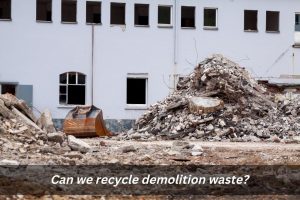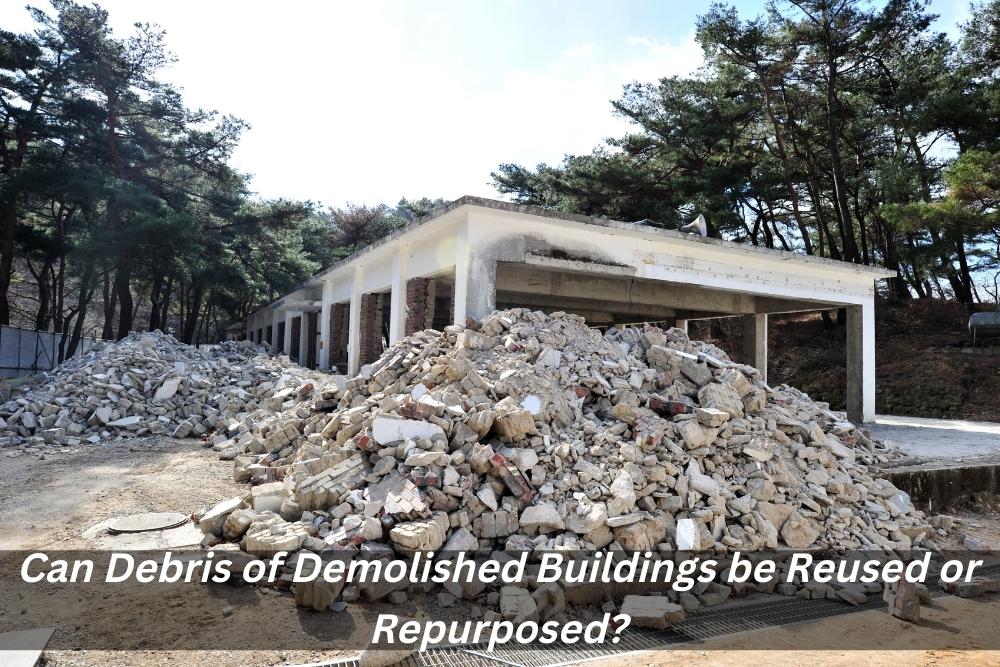Debris from demolition Central Coast projects often ends up in landfills where they take up valuable space and cause environmental damage. Is there anything else you can do with these materials besides dumping them into landfills?
Debris from demolition projects often goes straight to landfill sites. This means that the material cannot be recycled and has to be disposed of properly. The problem is that landfills are becoming full and the cost of disposing of the waste is rising.
There are several ways to reuse or recycle construction debris. For example, you can turn it into building blocks, bricks, pavers, or even concrete. If you don’t want to build something new out of it, you can also use it to create garden beds, flower pots, planters, or other decorative items.
Can we recycle demolition waste?

The answer is yes! There are many companies who will pay for your demolition debris as long as you have a permit. These permits are called Demolition Permits. Most local governments require a demolition permit before any work can begin.
It’s important to know that different types of demolition waste need to go through specific processes to make sure they’re safe for people to handle. Some of these include:
– Asbestos Removal
– Lead Removal
– Mold Removal
If you’re looking to start a business recycling construction and demolition waste, then you’ll need to contact a company that specializes in this type of business. You can find one by searching online.
What’s the best way to reuse brick, concrete, etc.?
Have you ever wondered where you can recycle old bricks or concrete? Or maybe you want to create something unique out of those materials. In this video, I’ll show you some cool ways to repurpose these materials into other things.
Brick and concrete are two of the hardest building materials around. They’re also very common and affordable. If you live near a construction site, you might see tons of them lying around.
There are lots of ways to reuse old bricks and concrete. For instance, you can turn them into planters, garden benches, fireplaces, and even walls! And don’t forget about recycling them into new stuff.
Here are just a few ideas on how you could reuse them:
1) Turn an old brick into a planter. All you need is a hammer, nails, and a drill. Take the top off the brick using a hammer and nail. Then, drive a screw or nail all the way down. Finally, put the top back on. Now, fill the hole with soil and plant your favourite flowers or vegetables.
2) Make a bench out of concrete. It may sound like a lot of work but it really isn’t. First, get yourself a concrete saw. Next, cut the concrete into small pieces. Once that’s done, just stack the pieces and place them inside a plastic bag. Finally, spray paint the entire thing. That should do the trick!
3) Build a fireplace out of old concrete. To do this, you first need to dig a hole big enough to hold the entire piece of concrete. After that, mix cement and sand together until you reach the right consistency. Fill the hole with the mixture and let it dry overnight. Once it does, you can add rocks and gravel to finish it off.
4) Create wall panels out of old bricks. To do this, simply remove the mortar between each brick. Remove the bricks if necessary. Repeat this process until you’ve got the number of bricks you want. Put the bricks onto a flat surface and cover them with plaster. Let it dry. Once that’s done take away the plaster and voila! You now have beautiful white wall tiles.
5) Use concrete to create a floor. This project is similar to the previous one except instead of making wall panels, you’ll be removing concrete. Break up the chunks of concrete and spread them over a large area. Mix cement and water together until you get a thick paste. Spread the mixture evenly over the concrete and wait for it to harden. When it has dried completely, you can walk on it without worrying about it cracking.
6) Add concrete to existing structures. This is a great way to make any structure stronger. Simply break up the chunks of concrete, add them to the bottom of the foundation, and pour more concrete over it. Keep doing this as many times as needed until the desired strength is reached.
7) Add concrete to patios and sidewalks. Just like adding concrete to foundations, you can use concrete to repair patios and sidewalks. Simply chip away at the damaged areas and replace them with fresh concrete.
8) Rebuild your driveway. This is a great project for anyone who doesn’t have much experience working with concrete. The only tools you’ll need are a hammer, level, and string line. Hammer holes in the ground and string lines across them. Lay the blocks along the strings and level them using a long level. Place spacers between the blocks and then fill the spaces with concrete.
9) Repair broken walls. If you’re having problems with crumbling or cracked walls, try repairing them yourself. Simply apply some mortar and fill in the cracks. Wait for it to set and then give it time to dry before painting.
10) Build outdoor furniture. This can be anything you’d like. Chairs, tables, benches — even whole house facades! All you need to start building is wood, nails, screws, and glue.
11) Install garden edging. For an easy and attractive look, install edging around your flowerbeds and gardens.
12) Add borders to driveways and paths. Want to turn an ordinary bath into something special? Try adding borders to it by placing pavers or stones. This will not only help beautify the space but also improve its usability.
13) Add a retaining wall to the backyard. Retaining walls come in handy when you don’t have a lot of land to work with. They allow you to build a small wall that won’t affect the overall layout of your yard.
14) Make a decorative border for a pathway. Decorative borders are perfect for pathways because they not only add beauty to the path but also protect it from wear and tear.
15) Build a fence. Fences come in all shapes and sizes. Some people prefer wooden fences while others go for vinyl ones. Whatever type of fence you choose, you should always pick one that complements the overall design of your home.
How long can debris be stored before it starts rotting away?
If you have any kind of garbage that has been sitting around for a while, it will start to decompose when exposed to oxygen and microbes. Debris left on the ground longer than about three months will begin to rot. In the case of organic waste like food scraps and yard trimmings, this may take much less time (about two weeks). For inorganic materials like metals or glass, there’s no limit at all. These materials will continue to decay indefinitely.
What happens if I leave trash out too long?
The most common problem associated with leaving trash outside is that it attracts animals. Animals such as raccoons, opossums, skunks, foxes, coyotes, birds, etc., will find the trash irresistible and eat it. If you want to keep your trash safe from these creatures, you must put it inside a container. A plastic baggie is ideal for this purpose. You can also cover trash cans with lids.
Can we recycle the concrete and steel from demolished buildings?
Concrete and steel are two of the most common materials found on construction sites around the world. If these materials are collected properly, they can be recycled material into new building materials. Can we really reuse them?
Concrete is a composite material composed mainly of cement paste (which contains lime) mixed with sand or gravel, water, and other additives. Steel is a malleable iron alloy usually containing carbon and manganese. It has high tensile strength, ductility, hardness, heat resistance, and corrosion resistance.
There are several ways to recycle concrete and steel. The most effective method is to convert them into aggregate that can be used for road paving. This requires high-temperature heating and grinding processes. However, some companies are now working on developing cheaper recycling methods.
Are there any government regulations concerning the disposal of demolition debris?
In many countries, municipal governments require builders to dispose of certain types of waste materials responsibly. There are specific guidelines regarding what kinds of materials can be disposed of where, how, and when. Most cities also have their own solid waste management plans.
Some municipalities have special programs set up specifically for demolishing old homes. They allow homeowners to get rid of their unwanted houses by paying an affordable fee instead of having to pay to have them hauled off to landfills.
Why do we need to remove asbestos from our homes?
Asbestos is a naturally occurring mineral fibre that was once commonly used in insulation, fireproofing, floor tiles, ceiling tiles, roof shingles, and more. Unfortunately, it can cause serious health problems, including cancer. Asbestos fibres can become airborne during demolition job activities, so it’s important to clean up after a house demolition work.
If you’re looking for more information about demolition, please visit our Facebook page.







